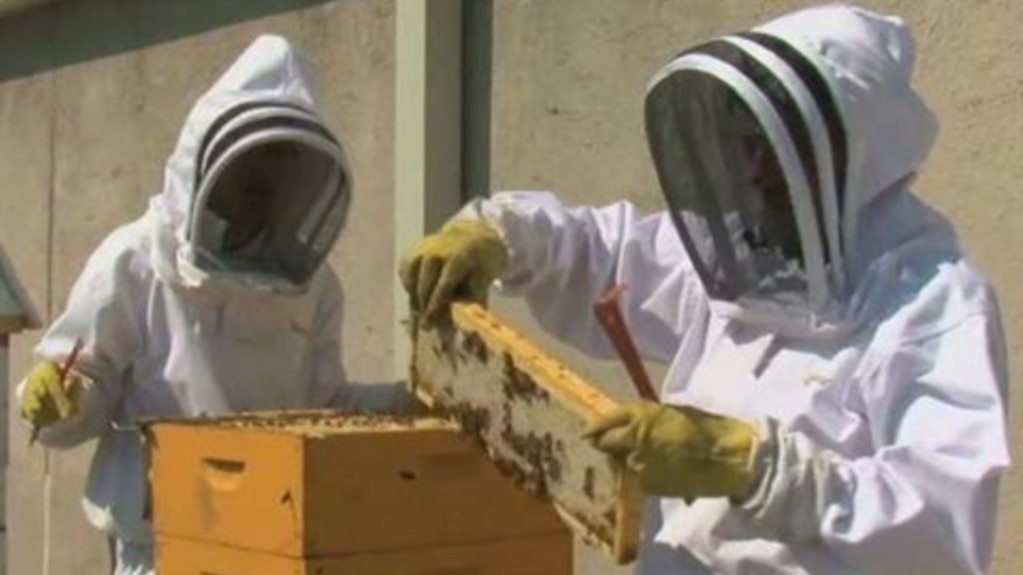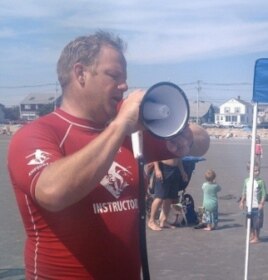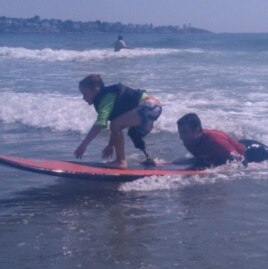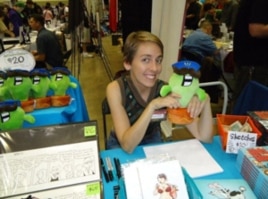
SHIRLEY GRIFFITH: Welcome to THIS IS AMERICA in VOA Special English. I’m Shirley Griffith.
MARIO RITTER: And I’m Mario Ritter. This week on our program, we meet a man who shares his love of surfing with people with disabilities. We also learn where two chefs in Washington are getting fresh honey for their restaurant. And we look at the growing popularity of webcomics.
(MUSIC)
SHIRLEY GRIFFITH: Dana Cummings lost his left leg in a car accident. Later he learned how to surf. Now, he teaches other people with disabilities how to ride the waves.
Dana Cummings started an organization in two thousand three called AmpSurf. AmpSurf is based in California. It offers free surfing classes to amputees and people with other disabilities. The group gets help from private donors and volunteers.
This year, Ampsurf took its services to the East Coast for the first time.

(SOUND)
MARIO RITTER: Dana Cummings has come to a beach on the Atlantic coast in the northeastern state of Maine. He is teaching Matthew Fish. Matthew is twenty-seven years old and visually impaired.
MATTHEW FISH: “I can see, like, the foam, the white cap, and I can see the wave, but I can’t really tell what form it is or if it’s ride-able.”
Dana Cummings puts Matthew’s hand on his shoulder. He leads him into chest-deep water, with the surfboard floating next to him.
DANA CUMMINGS: “You live with your grandma, right?”
MATTHEW FISH: “Yeah.”
DANA CUMMINGS: “Tell your grandma, ‘Grandma we’ve got to hit the beaches.’ Say, ‘Grandma, I’m stoked! I want to go surf.’ You got to teach her all the lingo. Grandma's surf lingo.”
Matthew starts by lying on the board. Dana Cummings and a couple of volunteers are nearby. It takes only a few tries before Matthew rises to his knees and rides a wave to shore.
MATTHEW FISH: “That was a thrill!”
DANA CUMMINGS: “You the man. Nice job, buddy!”
MATTHEW FISH: “Again! Again!”
DANA CUMMINGS: “Let’s do it again!”
And they keep doing it.
MATTHEW FISH: “I wiped out a couple of times, but as I always say, if you don’t fall once in while you’re not having enough fun.”
SHIRLEY GRIFFITH: Dana Cummings went to work as a software engineer after he left the military. He was a Marine during the nineteen ninety Gulf War. He survived two tours of duty -- only to lose his leg in a car accident in two thousand two. He says his feelings about life changed after the crash.
DANA CUMMINGS: “You know, I was just existing, not living. You know, it took me to lose my leg to get me to realize how precious life is and get off the couch and start living. I has been the best of me. I mean I do more things now than I ever did before.”
MARIO RITTER: Disabled people have more sports programs available than ever before -- skiing, soccer, basketball. But surfing classes are less common. The eleven students on the beach in Maine have come from all over the Northeast to learn.
One family drove six hours from New Jersey. They are joined by more than thirty volunteers who have taken time from work to help Dana Cummings.
DANA CUMMINGS: “How’s everybody feeling? Feeling good.”
SHIRLEY GRIFFITH: Brian Foss from New Hampshire is fifty-seven. He got sick from the polio virus early in life.
BRIAN FOSS: “I had polio in nineteen fifty-five, when I was two years old, the year the vaccine came out, actually. I missed it by a little bit.”
Brian has weakness in his legs and walks with crutches. But he loves downhill skiing, bicycling -- and now surfing.
BRIAN FOSS: “It’s a sense of being able to fly and a sense of freedom. You know, you’re not constrained by gravity, almost.”
MARIO RITTER: The youngest participant in the class, at six and a half years old, is Shaun McLaughlin from Massachusetts. He was born without a right foot. He received a prosthetic device before he could walk.

Shaun demonstrated surfing on the sand.
SHAUN MCLAUGHLIN: “You got to lay down like this and stand up and that’s pretty much how you do it.”
REPORTER: “That’s all?”
SHAUN MCLAUGHLIN: “Uh-huh.”
DANA CUMMINGS: “Most people with disabilities their whole life, everybody focuses on their disability. Who cares -- you lost your leg, you’re blind, whatever. Have fun. Just enjoy life. Take the most advantage of it as you can.”
SHIRLEY GRIFFITH: Dana Cummings plans to develop more of an East Coast presence for AmpSurf. He and his staff expect to return to Maine, New York and New Jersey next year. They want to train volunteers to become instructors and teach more people with disabilities to become surfers.
(MUSIC)
MARIO RITTER: The local food movement is the popular trend toward buying and eating locally produced foods. Two chefs at a Washington hotel decided to take the local food movement to new heights. They have three beehives producing honey on the hotel roof, ten floors above their restaurant. Ian Bens is the executive sous chef at the hotel, the Fairmont in Washington, DC.
IAN BENS: “All these bees have been out getting nectar and now they’re coming in and they want to get back in the hive.”
SHIRLEY GRIFFITH: Ian Bens and Aron Weber, the executive pastry chef, wanted fresh honey to use in their menus. So, two and half years ago, they put the beehives on the roof and have been harvesting them ever since.
They estimate that about sixty to ninety thousand honeybees live in each hive at the height of nectar flow. The busy season for the bees is from May through late July.
MARIO RITTER: Several wooden boxes are placed one on top of another to form each hive. The boxes are forty by fifty centimeters and are called supers. Bottom supers are usually deeper than the others. They house the queen bee and her brood of baby bees.
The worker bees use the supers above to store most of the honey they make.
Each super contains ten frames in which the bees build a wax honeycomb. They use the structure to house the queen’s eggs and to store honey and pollen to eat. As each comb is filled with honey, the bees seal it with wax. Then they continue to move higher up the hive, filling new frames of honeycomb.
SHIRLEY GRIFFITH: The Fairmont’s rooftop bees travel up to five kilometers to collect nectar and pollen from plants and flowers. They fly around parks and gardens in Washington.
The chefs remove the frames that have been filled and harvest the honey every month or so during warm weather.
MARIO RITTER: Ian Bens uses a special warming knife to remove the thin layer of wax that the bees have formed on top of the honey. The beeswax will later be used to create skin products like lip balm, sunscreen and facial scrubs for hotel guests.
The first step is to open the cells of honey. Then Aron Weber takes the prepared frames to an extracting machine. He places them, two at a time, into what looks like a giant metal can. He turns the handle on top to start them spinning around.
ARON WEBER: “What we’re going to do now is we have both frames in there, and we’re going to start spinning it, as we spin, the honey is going to go down the outside and drip down to the bottom."
Using this extraction method helps prevent damage to the honeycomb within the frame so the bees can reuse it.
SHIRLEY GRIFFITH: This extraction produces about twenty-two kilos of fresh honey. The Fairmont chefs will start adding it to their foods. On this day, they serve it with locally made cheeses. They also mix it into ice cream and the hotel's "BeeTini," a drink made with vanilla vodka and fresh lemon juice.
So far this season, which started in May, the chefs have collected about forty-five kilos of honey.
Ian Bens says other hotels across the country and the world have also turned to beekeeping as a way to get fresh honey.
IAN BENS: “People are going back to nature. You can see it especially on the East Coast and West Coast. You see it in New York City. Urban beekeeping, I think, is huge. I think as we live more in cities we realize how much nature is important to us.”
(MUSIC)
MARIO RITTER: Webcomics are comic strips published online by artists. In the past, comic strip artists usually tried to sell their comics to syndication companies to publish in newspapers. But now, for many artists, syndication is no longer the goal. The growing popularity of webcomics means that the artists can take their work directly to fans, and even earn money doing it.
SHIRLEY GRIFFITH: Davan is a young man, the main character in a webcomic called "Something Positive" by Randy K. Milholland.
RANDY MILHOLLAND: “When I started the comics off, he was who I had been a couple of years earlier.”
Randy Milholland created the comic ten years ago after he lost a job. He says Davan has changed over the years.
RANDY MILHOLLAND: “Early in the comic, he was very sarcastic, always negative. He would rather make snarky retorts than actually act to make things better.”
Randy Milholland continued the comic for fun after he got a new job. But doing it as a hobby meant fewer comics.
RANDY MILHOLLAND: “When I was doing comics every other week, therefore I was missing updates. Readers were complaining about it. So I kind of issued a challenge that if they wanted to pay my salary from my day job, I would quit my day job and focus only on the comics.”
They did – and he became a full-time comic artist on the Web. His website averages two hundred fifteen thousand page views a day.
MARIO RITTER: By some estimates there are thirty-six thousand webcomic creators worldwide. Randy Milholland earns money through advertising and sales of T-shirts and other products online.

So does Danielle Corsetto. She is the creator of “Girls with Slingshots.” Ms. Corsetto drew her first comic strip when she was eight years old. Now, she updates “Girls with Slingshots” five times a week. About twenty-five thousand people read her comics online each day.
DANIELLE CORSETTO: “Part of the reason, I think, that we’ve become successful is that we put a lot of our personality directly into the strip.”
SHIRLEY GRIFFITH: Laura Weiner is a big fan of webcomics. She follows around thirty-five comic strips online.
LAURA WEINER: “Reading them online, it’s a little more intimate than just going to a comic store and purchasing a mass-produced comic book.”
MARIO RITTER: Michael Uslan is an artist who was among the first instructors to teach university classes on comic book folklore. He says webcomics are getting noticed.
MICHAEL USLAN: “I do know that many of the studios and talent agencies and comic book companies troll these websites.”
(MUSIC)
SHIRLEY GRIFFITH: Our program was written and produced by Brianna Blake with reporting by Josie Huang, Julie Taboh and Faiza Elmasry. I’m Shirley Griffith.
MARIO RITTER: And I’m Mario Ritter. You can find links to "Something Positive" and "Girls with Slingshots" at voaspecialenglish.com. You can also tell us your favorite webcomics and read and listen to all of our programs online. Join us again next week for THIS IS AMERICA in VOA Special English.


